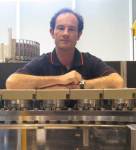Future Boron: Virtual Synthesis is the Next Phase
What does it look like?

Two views of a possible new high-pressure allotrope of Boron - B56.
What is it?
It's an allotrope of Boron. Maybe. In a previous C-365 blog episode, we described an allotrope of Boron that was discovered in 1951. And when we say "discovered" we mean "someone found a crystal, measured it and did the crystallography".
The cubic B56 structure shown above is a high-pressure phase described in a recent open-access paper. The catch? No one knows if it actually exists or not. The structure is one of a number "hand created" using some plausible hypotheses and then computer modeled using density functional theory to see if it was "stable". The "in the box" synthesis of computational chemistry is not new, but, in another example of how the world has been changed by Moore's Law, has become a routine part of the chemist's toolbox. Still, as the old saying goes, a computer can make more mistakes in a day than you can in a lifetime.
Where does the structure come from?
The paper is: Fan et al., "Phase transitions, mechanical properties and electronic structures of novel boron phases under high-pressure: A first-principles study." Scientific Reports 4, 6786 doi:10.1038/srep06786






